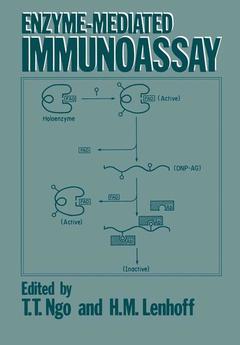Description
Enzyme-Mediated Immunoassay, Softcover reprint of the original 1st ed. 1985
Coordinators: Lenhoff H.M., Ngo That T.
Language: English
Subjects for Enzyme-Mediated Immunoassay:
Keywords
Pet; Plasma; Vine; antibody; biology; cell; cell biology; development; enzyme; enzymes; radioactivity
Publication date: 03-2012
498 p. · 17x24.4 cm · Paperback
498 p. · 17x24.4 cm · Paperback
Description
/li>Contents
/li>
T. T. Ngo and H. M. Lenhoff Department of Developmental and Cell Biology University of California, Irvine, CA 92717 In 1959, Yalow and Berson used insulin labeled with radioactive iodine to develop a quantitative immunological method for determining the amount of insulin in human plasma. Their method depends upon ~ competition between insulin labeled with radioactive iodine (II 1) and unlabeled insulin from plasma for a fixed and limited number of specific binding sites on the antibody to insulin. The amount of the labeled insulin bound to the antibody is inversely proportional to the amount of insulin in the plasma sample. Their method, which is so elegantly simple in concept, is made possible by the ability to detect with ease extremely low levels of radioactivity, and by the exquisite specificity of an antibody capable of specifically binding the analyte. Such a combination of sensitivity and specificity is the basis of this versatile analytical tool called radioimmunoassay (RIA). Twelve years later, Engvall and Perlmann (1971) and Van Weemen and Schuurs (1971) independently introduced the use of enzymes as another category of sensitive and even more versatile labels for use in immunoassays. Engvall and Perlmann (l971) coined the term ELISA, which stands for Enzyme Linked Immunosorbent Assay.
Enzyme Mediated Immunoassay: An Overview.- Separation-Free (Homogeneous) Enzyme Mediated Immunoassays.- Separation-Free Enzyme Immunoassay for Haptens.- Enzyme Modulator as Label in Separation-Free Immunoassays: Enzyme Modulator Mediated Immunoassay (EMMIA).- Prosthetic Group Labeled Enzyme Immunoassay.- Fluorogenic Substrate Labeled Separation-Free Enzyme Mediated Immunoassays for Haptens and Macromolecules.- Immunoassays Based on Conformational Restriction of the Enzyme Label Induced by the Antibody.- Nonseparation Enzyme Immunoassays for Macromolecules.- Liposome-Entrapped Enzyme Mediated Immunoassays.- Test Strip Enzyme Immunoassay.- Separation-Free Enzyme Fluorescence Immunoassay by Continuous Flow Injection Analysis.- Seperation-Required (Heterogenous) Enzyme Immunoassay.- Separation-Required (Heterogeneous) Enzyme Immunoassay for Haptens and Antigens.- Enzyme Immunoassay of Antibody.- The Amplified Enzyme-Linked Immunosorbent Assay (a-ELISA).- Affinity Column Mediated Immunoenzymetric Assays.- Steric Hindrance Enzyme Immunoassay (SHEIA).- Maleimide Derivative of Hapten for Enzyme Coupling in EIA.- Enzyme Immunoassay Using Tagged Enzyme-Ligand Conjugates.- Fluorimetric Measurements in Enzyme Immunoassays.- Radial Partition Enzyme Immunoassay.- Development of Immunochemical Enzyme Assays for Cardiac Isoenzymes.- Enzyme-Linked Immunoelectrotransfer Blot (EITB).- Enzyme Immunoassays for Tropical Parasitic Diseases.- Monoclonal Antibodies in Immunoenzymetric Assays.- The Ngo-Lenhoff (MBTH-DMAB) Peroxidase Assay.- Immunoperoxidase Techniques Using the Avidin-Biotin System.- Contributors.
© 2024 LAVOISIER S.A.S.
These books may interest you

Nonisotopic Immunoassay 52.74 €



